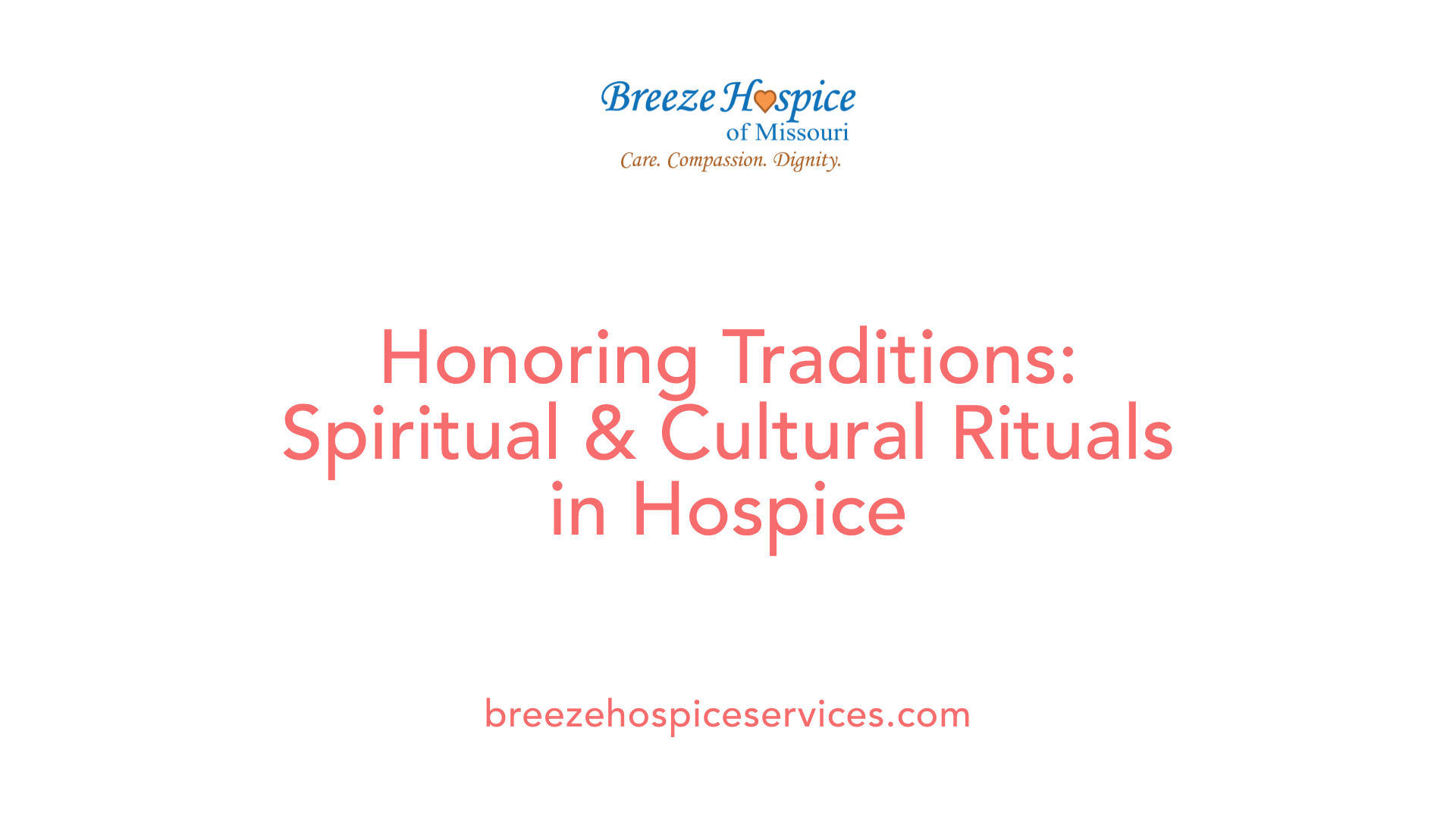How hospice services cater to the cultural needs of patients
July 25, 2025
Enhancing End-of-Life Care through Cultural Competence

Understanding the Importance of Cultural Sensitivity in Hospice
As the demographic landscape shifts towards greater diversity, hospice services are increasingly recognizing the vital importance of culturally sensitive care. Providing hospice care that respects cultural beliefs, practices, and communication styles ensures that patients and families experience dignity, comfort, and trust during life’s final chapter. This article explores how hospice services adapt to meet diverse cultural needs, the best practices for implementation, and the overarching significance of cultural competence in end-of-life care.
Foundation of Culturally Competent Hospice Care

What is the role of cultural competence in hospice care?
Cultural competence plays a crucial role in the delivery of hospice care, especially as the population of diverse cultural groups grows in the United States. It involves understanding, respecting, and responding to the unique cultural backgrounds of each patient. This approach fosters trust, enhances communication, and ensures that care plans align with the patient's cultural values and beliefs.
Hospice care that is culturally competent respects traditional healing practices, religious rituals, and family dynamics. It creates an environment where patients feel safe, understood, and valued. Training healthcare professionals in cultural awareness and knowledge helps bridge gaps caused by cultural misunderstandings, reducing disparities and promoting equitable access to quality end-of-life care.
The overall goal is to provide holistic, respectful care that addresses the emotional, spiritual, and social needs of patients and their families, acknowledging the importance of cultural identity in the dying process.
How do cultural beliefs shape patient experiences?
Cultural beliefs deeply influence how patients perceive illness, pain, death, and the dying process. For some communities, death is seen as a natural part of life, with rituals that promote spiritual transition and community involvement. Others may view death with fear or taboo, avoiding discussions about prognosis or end-of-life options to protect loved ones.
Beliefs regarding pain expression vary; certain cultures may discourage visibly expressing pain, relying instead on natural remedies or stoic acceptance. Attitudes toward medical interventions, including the use of hospice services, are shaped by cultural values around autonomy, family involvement, and trust in healthcare providers.
Families often play a central role in decision-making, especially in collectivist cultures, which may involve extended family members and religious leaders. Recognizing and respecting these beliefs ensures that care remains person-centered and culturally appropriate.
Why is ongoing self-assessment and staff training necessary?
Providing culturally competent hospice care requires continuous self-assessment by healthcare organizations and ongoing education for staff. Self-assessment helps identify gaps in knowledge, biases, and systemic barriers that may hinder culturally sensitive practice.
Regular training, including workshops, scenario-based learning, and feedback sessions, equips healthcare workers with skills to communicate effectively across cultural differences and handle complex end-of-life conversations. Such training emphasizes humility, active listening, and adaptability—critical components of cultural competence.
Furthermore, involving diverse staff and community partners enhances cultural insights and expands the organization’s capacity to serve different populations effectively. This commitment to learning and reflection supports the delivery of compassionate care aligned with each patient's cultural identity, ultimately improving satisfaction and health outcomes.
How can hospices accommodate cultural needs best?
Effective accommodation of cultural needs begins with understanding each patient’s unique preferences through cultural assessments. These assessments include questions about religious beliefs, traditional practices, family involvement, and language needs.
Care providers should incorporate cultural considerations into all aspects of care planning. This might involve respecting dietary restrictions, facilitating religious rituals, or adjusting communication methods, such as using interpreters or visual aids.
Collaborations with community leaders, faith-based organizations, and traditional healers can reinforce trust and ensure cultural practices are honored. Creating a welcoming environment with culturally diverse resources, including artwork, literature, and signage, further enhances comfort.
Supporting families by involving them in decision-making and understanding their grief rituals promotes emotional support and respect for cultural mourning practices. Training staff to be flexible, sensitive, and knowledgeable about various cultural backgrounds ensures that each patient's individuality is honored.
How do healthcare providers ensure culturally sensitive hospice and end-of-life care?
Healthcare providers can uphold cultural sensitivity by adopting organizational policies built on principles of respect, equity, and inclusion. Such policies include ongoing training programs about cultural awareness, linguistic competence, and ethical considerations.
Utilizing interpreter services and hiring bilingual or multicultural staff helps bridge communication gaps. Building partnerships with community organizations and faith leaders fosters trust and facilitates access for underserved groups.
Implementing cultural assessment tools, like Kleinman’s model, enables providers to gather meaningful cultural data, guiding personalized care plans. Regular feedback from patients and families further refines practices, ensuring they remain relevant and respectful.
In addition, organizations should promote an environment where staff feel supported in discussing cultural challenges and sharing best practices. Continuous evaluation and adaptation of policies are essential for maintaining high-quality, culturally sensitive care.
How do cultural beliefs influence perceptions of death and dying?
Cultural beliefs shape perceptions of death by influencing attitudes towards the dying process, rituals, and mourning. Some cultures view death as a transition to the afterlife, emphasizing spiritual preparation and ceremonial practices. Others see death as a final ending, with little emphasis on spiritual closure.
These beliefs impact decisions about where to die, acceptance of certain treatments, and preferences for funeral and memorial rites. For example, some communities prefer to die at home surrounded by family, while others may prefer institutional settings for religious reasons.
Religious and spiritual practices, such as prayer, body washing, or specific body positioning, are integral to many cultures and support a peaceful transition. Understanding these beliefs helps healthcare professionals care for the whole person, respecting their cultural context and honoring their wishes.
What are best practices for accommodating the cultural needs of patients in hospice care?
Best practices include conducting thorough cultural assessments early in care, engaging patients and families in open dialogue about their cultural values, and tailoring care accordingly. Respecting religious and spiritual rituals, offering language assistance, and involving cultural mediators are crucial strategies.
Healthcare teams should receive targeted training to build skills in cultural humility, effective communication, and conflict resolution. Incorporating traditional practices into the care plan, when appropriate, demonstrates respect and fosters trust.
Creating a culturally inclusive environment involves staff diversity, culturally relevant educational materials, and visible symbols of respect for multiple traditions. Empowering patients to participate actively in decision-making affirms their cultural identity.
Ultimately, flexible, person-centered approaches that acknowledge and preserve each individual’s cultural heritage promote dignity and comfort at the end of life.
Organizational Strategies to Foster Cultural Competence

What are the stages of cultural competence development?
Building cultural competence within healthcare organizations involves progressing through distinct stages, starting from destructive practices to achieving proficiency. Initial stages may include stereotyping or dismissiveness, often rooted in lack of awareness or training. Over time, organizations can evolve by conducting self-assessments, engaging in staff development, and developing policies that foster inclusivity.
The stages typically include:
| Stage | Description | Key Activities |
|---|---|---|
| Destructiveness | Unaware or actively dismissive of cultural differences | Lack of training, stereotypes, cultural biases |
| Incapacity | Acknowledgment of cultural gaps but without effective action | Initial awareness programs, resistance to change |
| Competence | Intentional efforts to improve cultural understanding | Staff training, risk assessments, policy reforms |
| Proficiency | Integration of cultural competence into all levels of service | Continuous learning, community partnerships, measurement of outcomes |
Advancing through these phases requires dedication to learning, openness to change, and ongoing evaluation.
The Role of Spiritual & Cultural Rituals in Hospice Care

How can healthcare providers ensure culturally sensitive hospice and end-of-life care?
Healthcare providers can ensure culturally sensitive hospice and end-of-life care by adopting comprehensive practices that respect the diverse backgrounds of their patients. This involves ongoing training programs in cultural competence, which equip staff with the skills to understand and honor various cultural beliefs, communication styles, and customs.
Utilizing interpreter services and recruiting personnel from minority groups can significantly improve communication and trust. These steps help tailor care plans to fit each patient’s social, spiritual, and linguistic needs, ensuring that individual preferences are honored.
Creating partnerships with traditional healers, faith leaders, and community health workers also enhances trust and provides culturally appropriate support. Organizational policies that reduce barriers—such as offering language access services and incorporating health equity tools—are critical.
Organizations like the National Center for Cultural and Linguistic Competence provide valuable resources to develop inclusive strategies that address disparities.
Summary of strategies:
- Staff training in cultural competence
- Interpreter services and bilingual staff
- Recruitment of diverse personnel
- Collaborations with community figures
- Policy development for health equity
These efforts collectively foster an environment where culturally sensitive, respectful care can flourish, especially at the sensitive time of end-of-life for diverse populations.
What are best practices for accommodating the cultural needs of patients in hospice care?
Best practices involve engaging deeply with patients and their families to understand their specific cultural and spiritual preferences. Open, respectful dialogue helps clarify beliefs, rituals, and end-of-life wishes.
Providers should incorporate these insights into personalized care plans, respecting religious views, dietary restrictions, and traditional practices, while also maintaining dignity and respecting personal choices.
Cultural competence training for staff is vital, enabling them to recognize and respect diverse norms and customs. Creating an inclusive environment—through culturally sensitive decor, celebratory practices, or ritual spaces—can help patients feel safe and respected.
Supporting person-centered care that involves family members and caregivers enhances cultural alignment and decision-making. Such practices promote trust and improve comfort levels, making the hospice environment more welcoming and safe for patients of varied backgrounds.
How do cultural beliefs influence perceptions of death and dying?
Cultural beliefs fundamentally shape how individuals conceive death and the dying process. Some cultures view death as a transition—an entry into an afterlife or spiritual continuation—while others see it as a biological end.
These beliefs influence rituals, mourning practices, and decisions related to palliative interventions. For example, some communities may prioritize rituals like prayer, body washing, or specific body positioning as essential parts of the dying process.
Cultural perspectives also affect emotional responses to death, influencing grief and support approaches. In some traditions, family involvement is paramount, with decision-making often collective rather than individual.
Understanding these diverse perceptions helps healthcare providers offer support that respects and aligns with each person’s cultural worldview, fostering dignity and peace in the final stages of life.
Additional Insights on Cultural & Spiritual Practices in Hospice Care
| Aspect | Considerations | Details |
|---|---|---|
| Spiritual & Religious Practices | Respecting specific rituals and ceremonies | Examples include prayer, religious bathing, body positioning, and ritual prayers or offerings |
| Involving Faith Leaders | Collaborating with spiritual advisors | Engaging clergy or spiritual leaders to support patients’ spiritual needs and guide end-of-life rituals |
| Respecting Rituals & Cultural Identity | Accommodate traditional customs | Customary practices such as fasting, specific dress, or cultural mourning rituals can be integrated into care plans |
Summary: Culturally competent hospice care involves understanding various traditions and beliefs about death, and respectfully incorporating them to honor each patient's identity and spiritual needs. This approach nurtures emotional well-being and provides reassurance during a vulnerable time.
Strategies for Enhancing Cultural & Spiritual Engagement
- Engage with patients and families early to discuss cultural preferences.
- Involve cultural mediators or community leaders in care planning.
- Offer language and interpretation services.
- Incorporate traditional practices into care routines whenever possible.
- Respect spiritual and religious rituals associated with death and mourning.
Through these practices, hospice providers create a supportive environment that recognizes and values cultural diversity.
| Practice Area | Approach | Impact |
|---|---|---|
| Staff Training | Ongoing cultural competence education | Better understanding of diverse beliefs and practices |
| Cultural Inclusion | Modifying care environment to reflect cultural diversity | Increased patient comfort and trust |
| Community Engagement | Partnering with cultural and religious groups | Enhanced trust and access among minority populations |
| Communication | Use interpreters, visual aids, and cultural brokers | Improved clarity and emotional support |
By systematically addressing cultural needs, hospice care can profoundly improve the quality and dignity of end-of-life experiences for all patients.
Cultural Competence as a Pillar of Quality Hospice Care
Adapting hospice care to align with the cultural needs of diverse patient populations is essential for delivering holistic, respectful, and effective end-of-life support. It requires an organizational commitment to cultural competence through training, community engagement, and policy development. Incorporating cultural and spiritual practices not only enhances patient and family comfort but also fosters trust, satisfaction, and better health outcomes. As demographic trends continue to diversify, hospice services must evolve to uphold the principles of respect, inclusivity, and compassion, ensuring that every individual’s cultural identity is honored throughout their end-of-life journey.
References
- Culturally Competent Care for Seriously Ill Patients - PubMed Central
- Cultural Sensitivity In Hospice Care - Las Vegas
- What are the Leading Cultural Factors in Hospice Care? - Alora Health
- Cultural Relevance in End-of-Life Care - EthnoMed
- A Guide to Culturally-Competent Nursing Care
- The Growing Importance of Cultural Sensitivity in Hospice Services
- How do cultural factors influence the provision of end-of-life care? A ...



































































































